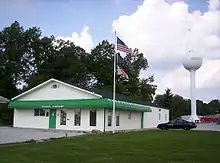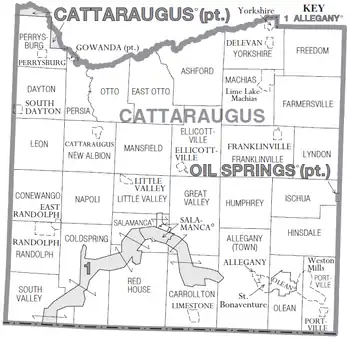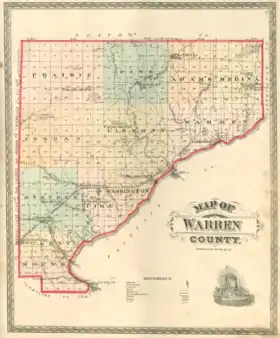Civil township
A civil township is a widely used unit of local government in the United States that is subordinate to a county. The term town is used in New England, New York, and Wisconsin to refer to the equivalent of the civil township in these states. Specific responsibilities and the degree of autonomy vary based on each state. Civil townships are distinct from survey townships, but in states that have both, the boundaries often coincide and may completely geographically subdivide a county. The U.S. Census Bureau classifies civil townships as minor civil divisions. Currently, there are 20 states with civil townships.
| This article is part of a series on |
| Political divisions of the United States |
|---|
 |
| First level |
|
|
| Second level |
|
| Third level |
|
|
| Fourth level |
| Other areas |
|
|
|
United States portal |
Township functions are generally overseen by a governing board (the name varies from state to state) and a clerk, trustee, or mayor (in NJ townships and Utah metro townships). Township officers frequently include justice of the peace, road commissioner, assessor, constable, and surveyor. In the 20th century, many townships also added a township administrator or supervisor to the officers as an executive for the board. In some cases, townships run local libraries, senior citizen services, youth services, disabled citizen services, emergency assistance, and even cemetery services. In some states, a township and a municipality that is coterminous with that township may wholly or partially consolidate their operations.
Midwestern and central

Depending on the state, the township government has varying degrees of authority.
In the Upper Midwestern states near the Great Lakes, civil townships (known in Michigan as general law townships[1] and in Wisconsin as towns), are often, but not always, overlaid on survey townships. The degree to which these townships are functioning governmental entities varies from state to state and in some cases even within a state. For example, townships in the northern part of Illinois are active in providing public services—such as road maintenance, after-school care, and senior services—whereas townships in southern Illinois frequently delegate these services to the county. Most townships in Illinois also provide services such as snow removal, senior transportation, and emergency services to households residing in unincorporated parts of the county. The townships in Illinois each have a township board, whose board members were formerly called township trustees, and a single township supervisor. In contrast, civil townships in Indiana are operated in a relatively consistent manner statewide and tend to be well organized, with each served by a single township trustee and a three-member board.
Civil townships in these states are generally not incorporated, and nearby cities may annex land in adjoining townships with relative ease. In Michigan, however, general law townships are corporate entities (e.g. they can be the subject of lawsuits),[2] and some can become reformulated as charter townships, a status intended to protect against annexation from nearby municipalities and which grants the township some home rule powers similar to cities. In Wisconsin, civil townships are known as "towns" rather than townships, but they function essentially the same as in neighboring states. In Minnesota, state statute refers to such entities as towns yet requires them to have a name in the form "Name Township". In both documents and conversation, "town" and "township" are used interchangeably. Minnesota townships can be either Non-Urban or Urban (giving the township government greater power), but this is not reflected in the township's name.[3] In Ohio, a city or village is overlaid onto a township unless it withdraws by establishing a paper township. Where the paper township does not extend to the city limits, property owners pay taxes for both the township and municipality,[4] though these overlaps are sometimes overlooked by mistake.[5] Ten other states also allow townships and municipalities to overlap.[6]
In Kansas, some civil townships provide services such as road maintenance and fire protection services not provided by the county.
Northeastern states

New England and New York
In New England, states are generally subdivided into towns and cities, which are fully functioning municipalities that provide most local services. With the exception of a few remote areas of New Hampshire and Vermont and about half of Maine, all of New England lies within the borders of an incorporated municipality. New England has counties, though in southern New England, they are strictly used as dividing lines for judicial systems and statistical purposes, while in northern New England, they may handle some law enforcement, education and other limited functions in addition to judicial systems. New England also has cities, most of which are towns whose residents have voted to replace the town meeting form of government with a city form.
In portions of Maine, New Hampshire, and Vermont, county subdivisions that are not incorporated are occasionally called townships, or by other terms such as "gore", "grant", "location", "plantation", or "purchase".
The State of New York is subdivided into counties, which are subdivided into towns - except for New York City, whose five coextensive counties for state government purposes are municipal boroughs for city government purposes (Bronx County/The Bronx, Kings County/Brooklyn, New York County/Manhattan, Queens County/Queens, and Richmond County/Staten Island). As in New England, the term "town" equates to "township" in most other states. Additionally, New Yorkers colloquially use the term "township" to mean “town”. Townships and hamlets are unincorporated areas within a town or towns. Because towns are administrative divisions of a county, town boundaries cannot cross county lines. In addition to administrative subdivisions, New York State also has cities and villages. These are municipal corporations and, thus, are able to cross county lines. In addition to usually being smaller than cities, villages are subordinate to the towns and counties in which they are located and village residents pay both village and town taxes. Cities, on the other hand, are fully autonomous jurisdictions within the state, whose governments are independent of town and county control.
Pennsylvania and New Jersey
A Pennsylvania township is a unit of local government, responsible for services such as police departments, local road and street maintenance. It acts the same as a city or borough. Townships were established based on convenient geographical boundaries and vary in size from six to fifty-two square miles (10–135 km2).
A New Jersey township is similar, in that it is a form of municipal government equal in status to a village, town, borough, or city, and provides similar services to a Pennsylvania township, and varies in size from one-tenth (Shrewsbury Twp.) to one-hundred (Jackson Twp.) square miles.
Southern states

In the South, outside cities and towns there is generally no local government other than the county.
North Carolina is no exception to that rule, but it does have townships as minor geographical subdivisions of counties, including both unincorporated territory and also land within the bounds of incorporated cities and towns (as well as the extraterritorial jurisdiction of municipalities). Every county is divided into townships as mandated since the North Carolina Constitution of 1868. Some urbanized counties such as Mecklenburg County (Charlotte) now number their townships (e.g. "Township 12") rather than using names. Townships all over the state used to have some official organization and duties but now are only considered ceremonial divisions of each county. Township names are still used quite extensively at the county government level in North Carolina as a way of determining and dividing up areas for administrative purposes; primarily for collecting county taxes, determining fire districts (e.g. Lebanon Township in Durham County gives its name to the Lebanon Volunteer Fire Department), for real estate purposes such as categorizing land deeds, land surveys and other real estate documents, and for voter registration purposes. In most areas of North Carolina that are outside any municipal limit (outside cities or towns), townships are used to determine voter polling places, and in most instances county election boards divide up their voter precincts by township. However, there is no government per se at the township level in North Carolina, and there are no elected or appointed offices associated with townships.
Western states
In 2015 Utah created a form of civil township called a metro township. While each metro township has a mayor[7] and township council, and manage a budget, and cannot be annexed without its permission,[8] its powers of taxation are limited, and must contract with other municipalities or municipal shared-service districts[9] for most municipal services (police,[10] for example). The five metro townships—all located in Salt Lake County—are Kearns, Magna,[11] Copperton, Emigration Canyon and White City.
States with civil townships
As of 2012, there were 16,360 organized town or township governments in the following 21 states:[12]
- Connecticut
- Illinois
- Indiana
- Kansas
- Maine
- Massachusetts
- Michigan
- Minnesota
- Missouri
- Nebraska
- New Hampshire
- New Jersey
- New York
- North Dakota
- Ohio
- Pennsylvania
- Rhode Island
- South Dakota
- Vermont
- Utah
- Wisconsin
States without civil townships
There were 29 states without organized town or township governments as of 2020:[12]
States which once had but no longer have civil townships
- California had townships at statehood. County boards of supervisors had the authority to create, consolidate, or abolish townships as late as the 1920s.[13]
- Iowa had 1,608 townships in 1942. By 1952, their responsibilities and functions had essentially been absorbed by their counties, were considered "vestigial", and were no longer counted.[14]
- Oklahoma did have civil townships statewide upon statehood. On August 5, 1913, Oklahoma voters passed the Oklahoma Township Amendment, also known as State Question 58. This allowed the creation or abolishment of townships on a county by county basis.[15] By the mid 1930s, all counties had voted to abolish them.[16] Their former names and boundaries were used for United States census counting purposes and census documentation through 1960, after which Census Counting Divisions (CCDs) were used.[17][18]
- South Carolina had 2 townships in 1952, those of Folly Island, and Sullivan's Island.[19]
- The 1870 Constitution of Virginia required the division of counties into townships, but an amendment in 1874 converted those townships into magisterial districts.[20]
- Washington had 70 townships in 1952, in only Spokane and Whatcom counties, for administration of local roads.[21]
See also
- Township (United States)
- Survey township
- Charter township
- Metro township
- County (United States)
- Political divisions of the United States
- Minor civil division
- Hundred (country subdivision)
- Township for other divisions called "township"
- Unorganized territory
- List of subnational entities
Notes
- "What is a Township?". Michigan Township Association. 2006-12-05. Archived from the original on 2006-09-29. Retrieved 2007-01-24.
- "CONSTITUTION OF MICHIGAN". www.legislature.mi.gov. Retrieved May 25, 2020.
- "Minnesota Statutes 368.01: Powers of Certain Metropolitan Area Towns". Retrieved 2008-06-04.
- "Commissioners Meeting" (PDF). Medina, Ohio: Medina County, Ohio. 2005-05-23. p. 5. Archived from the original (PDF) on 2008-09-19. Retrieved 2009-10-22.
Lynda Bowers, Lafayette Township Trustee, noted that we already have property that is dual citizenship and they pay taxes in 2 places. There is Chippewa Lake in Lafayette Township, Westfield Village in Westfield Township and Lodi in Harrisville Township.
- The State ex. rel. St. Clair Township Board of Trustees et al. v. The City of Hamilton et al., Ohio, 717 (2019).
- "Municipalities and Townships". Lists & Structure of Governments. Washington, D.C.: United States Census Bureau. 2009-06-08. Archived from the original on 2010-10-23. Retrieved 2009-10-22.
- "With a stroke of his pen, Utah governor gives township leaders the title of mayor". www.sltrib.com. Retrieved 2020-03-18.
- "What is a Metro Township? | Magna Utah". www.magnametrotownship.org. Retrieved 2020-02-22.
- "Greater Salt Lake Municipal Services District". msd.utah.gov. Retrieved 2020-03-19.
- "Meet the Unified Police Department of Greater Salt Lake". updsl.org. Retrieved 2020-03-18.
- "Metro Township of Magna, Utah". www.magnametrotownship.org. Retrieved 2020-03-18.
- United States Census Bureau. 2012 Census of Governments: Individual State Descriptions: 2012, Washington, DC: U.S. Department of Commerce, p. viii.
- Cal. Jur. 45.
- State and Local Government Special Studies: 1948-1961. U.S. Department of Commerce [and] U.S. Department of Labor. 1982.
- "Oklahoma Township Government, State Question 58 (August 1913) - Ballotpedia". Retrieved 2017-11-03.
- "Wagoner County - 1928 - 1937". www.ok.gov. Retrieved 2017-11-02.
- "NUMBER OF INHABITANTS - OKLAHOMA (1960)" (PDF). Archived from the original (PDF) on 2017-03-26.
- "NUMBER OF INHABITANTS - OKLAHOMA (1970)" (PDF). Archived from the original (PDF) on 2017-03-26.
- State and Local Government Special Studies: 1948-1961. U.S. Department of Commerce [and] U.S. Department of Labor. 1982.
- "A Guide to the Frederick County (Va.) Township Records, 1871-1875 Frederick County (Va.) Township Records, 1871-1875 1098656, 1098661, 1099105, 1018039". ead.lib.virginia.edu. Retrieved May 25, 2020.
- State and Local Government Special Studies: 1948-1961. U.S. Department of Commerce [and] U.S. Department of Labor. 1982.
External links
- National Association of Towns and Townships
- U.S. Census Bureau, Geographic Areas Reference Manual - Chapter 8: County Subdivisions